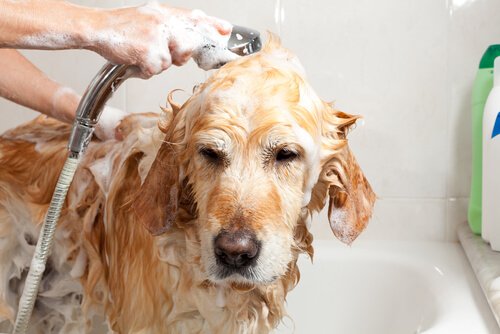How to Remove Fleas and Parasites from Your Pregnant Pet

If your pregnant pet fleas and parasites, as well as ticks, then you should get rid of them. This may especially worry you if your pet is pregnant. You may be wondering if the chemicals in these products affect the puppies or the mother? Let’s find out.
Are flea products safe for your pregnant pet?
When a female pet is pregnant, her hormone levels, sensitivity, and even some bodily functions change. This can lead to greater skin sensitivity, could cause an odor, or may even cause allergies that they previously didn’t have.
This is why you should take precautions when using these products. They’re generally topical and they don’t penetrate the skin. These keep the puppies safe, but it can still have an effect on your dog.
Pregnancy can cause skin hypersensitivity that may cause external damage or an allergy through the dog’s nose, resulting in discomfort that would affect the puppies.

However, these can be used as long as the vet says it’s okay and prescribes the best way to do it. Also be sure you’re following the indicated dosage and are taking into account your pet’s weight, age, and stage of pregnancy.
Even so, you may not like the idea of using chemicals on your pregnant pet. Are there other ways to get rid of fleas? Yes, let’s see how.
Removing fleas from a pregnant pet
If you opt for the more traditional methods, you have two options: remove them by hand, which requires a lot of patience, or with natural products.
If you’re determined and decide to remove your pet’s fleas by hand, then you’ll need gloves, hat, old clothes, essential oils, warm water, puppy shampoo, a lice comb, and a towel.
Put on your old clothes and cover your hair with a hat. If a flea jumps into your hair, you’re going to have even more problems. Use rubber or latex gloves to prevent any infections from developing. You should definitely use them if your pregnant pet has an infected wound caused by the fleas. The strong smelling essential oil will help repel the fleas. So, apply it to your gloves to keep them from jumping on you.
Fill a bathtub with warm water and gently place your dog into it. Be sure to speak to them while you’re doing so in order to calm them down. Remember that they’re pregnant, so stress and sudden movements are not good for them. Wet them well and apply the shampoo.

Massage your dog’s entire body by using circular motions. You’ll notice a lot of the fleas already falling off. At this point, you should comb your dog. Without rinsing the shampoo, comb your dog with the lice comb, which will drag away anything in their path because there is little space between the bristles.
Don’t leave the fleas in the tub, put them in a separate bucket of water. They can survive in water for a few minutes and may reattach themselves to your dog. Rinse the shampoo, dry your dog with a towel and give them a final inspection. There may be more fleas that you’ll have to remove by hand.
Homemade remedies for fleas
We believe the previous flea removal method is the best and least aggressive for your pregnant pet. However, if you want to use a homemade remedy, you can use any of the following:
- Combination of equal portions of oil and alcohol
- Chamomile infusion
- Lemon
- Apple cider vinegar
- Beer yeast
You can use a cotton ball to apply any of these remedies to your pet’s skin. They produce an odor that the fleas won’t like. They’ll run away! Due to these products being 100% natural, they won’t hurt your pet’s skin or nose.
If your pregnant pet fleas and parasites, as well as ticks, then you should get rid of them. This may especially worry you if your pet is pregnant. You may be wondering if the chemicals in these products affect the puppies or the mother? Let’s find out.
Are flea products safe for your pregnant pet?
When a female pet is pregnant, her hormone levels, sensitivity, and even some bodily functions change. This can lead to greater skin sensitivity, could cause an odor, or may even cause allergies that they previously didn’t have.
This is why you should take precautions when using these products. They’re generally topical and they don’t penetrate the skin. These keep the puppies safe, but it can still have an effect on your dog.
Pregnancy can cause skin hypersensitivity that may cause external damage or an allergy through the dog’s nose, resulting in discomfort that would affect the puppies.

However, these can be used as long as the vet says it’s okay and prescribes the best way to do it. Also be sure you’re following the indicated dosage and are taking into account your pet’s weight, age, and stage of pregnancy.
Even so, you may not like the idea of using chemicals on your pregnant pet. Are there other ways to get rid of fleas? Yes, let’s see how.
Removing fleas from a pregnant pet
If you opt for the more traditional methods, you have two options: remove them by hand, which requires a lot of patience, or with natural products.
If you’re determined and decide to remove your pet’s fleas by hand, then you’ll need gloves, hat, old clothes, essential oils, warm water, puppy shampoo, a lice comb, and a towel.
Put on your old clothes and cover your hair with a hat. If a flea jumps into your hair, you’re going to have even more problems. Use rubber or latex gloves to prevent any infections from developing. You should definitely use them if your pregnant pet has an infected wound caused by the fleas. The strong smelling essential oil will help repel the fleas. So, apply it to your gloves to keep them from jumping on you.
Fill a bathtub with warm water and gently place your dog into it. Be sure to speak to them while you’re doing so in order to calm them down. Remember that they’re pregnant, so stress and sudden movements are not good for them. Wet them well and apply the shampoo.

Massage your dog’s entire body by using circular motions. You’ll notice a lot of the fleas already falling off. At this point, you should comb your dog. Without rinsing the shampoo, comb your dog with the lice comb, which will drag away anything in their path because there is little space between the bristles.
Don’t leave the fleas in the tub, put them in a separate bucket of water. They can survive in water for a few minutes and may reattach themselves to your dog. Rinse the shampoo, dry your dog with a towel and give them a final inspection. There may be more fleas that you’ll have to remove by hand.
Homemade remedies for fleas
We believe the previous flea removal method is the best and least aggressive for your pregnant pet. However, if you want to use a homemade remedy, you can use any of the following:
- Combination of equal portions of oil and alcohol
- Chamomile infusion
- Lemon
- Apple cider vinegar
- Beer yeast
You can use a cotton ball to apply any of these remedies to your pet’s skin. They produce an odor that the fleas won’t like. They’ll run away! Due to these products being 100% natural, they won’t hurt your pet’s skin or nose.
All cited sources were thoroughly reviewed by our team to ensure their quality, reliability, currency, and validity. The bibliography of this article was considered reliable and of academic or scientific accuracy.
- FDA. (2021) Uso seguro de los productos para eliminar pulgas y garrapatas en las mascotas. Recuperado el 23 de mayo de 2022, disponible en: https://www.fda.gov/consumers/articulos-en-espanol/uso-seguro-de-los-productos-para-eliminar-pulgas-y-garrapatas-en-las-mascotas
- Esquivel, C. (2013) Gestación en la perra. Recuperado el 23 de mayo de 2022, disponible en: https://www.uv.mx/veracruz/fmvz/files/2013/04/Gestacion-en-la-perra.pdf
This text is provided for informational purposes only and does not replace consultation with a professional. If in doubt, consult your specialist.







